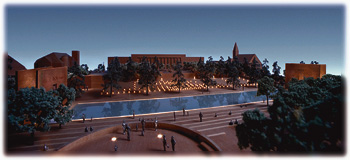Main Menu · Search · Current Issue · Contact · Archives · Centennial · Letters to the Editor · FAQs
![]()
Main Menu ·
Search · Current Issue · Contact · Archives · Centennial · Letters to the Editor · FAQs

| Lust for Books | The Micro-Menace of Biofilm |
| Oklahoma City: A Remembrance | Tighter, Safer Neighborhoods |
| "my home, ill, sick" | E-mail and Web Information |

|
It is not so much a day as a time--9:02 a.m.--that will live in infamy: the moment on April 19, 1995, when a tremendous bomb blast shattered the Alfred P. Murrah Federal Building in Oklahoma City and killed 168 persons, injuring hundreds more. Neither that event's repercussions nor its tragedy ended with the recent conviction of bomber Timothy McVeigh, and its remembrance will continue in the Oklahoma City National Memorial, to be constructed on a three-acre site that includes the Murrah Building footprint. The memorial's designers are Hans-Ekkehard Butzer and his wife, Torrey Butzer, with their colleague, Sven Berg. Hans-Ekkehard Butzer, who is entering an advanced program at the Harvard Graduate School of Design in the spring, says, "Some people wanted nothing built--to leave the rubble in place with a chain-link fence around it, as a reminder of the tragedy. But in that case, what are you memorializing? What you don't want to do is to memorialize the bombing, to glorify a criminal."
Instead, the Oklahoma City Memorial Foundation ran an international design competition last winter. They winnowed 624 entrants down to five finalists, and on April 19, 1997, exactly two years after the explosion, announced the winning design by the Butzers, who are both architects. The privately funded project has already raised $3.5 million of its $8.8 million budget, and hopes to complete the memorial by 1999.
The design creates an "outdoor room" on the site, according to the Butzers, and the memorial also includes an adjacent museum as well as a national institute for the prevention of terrorism and violence. The "outdoor room" (shown in the model above) includes a 300-foot-long reflecting pool lined with black stone, flanked at each end by 42-foot-high gates bearing inscriptions on their inner façades: 9:01 on the eastern gate, and on the western gate 9:03--the moments before and after the bombing. To the north, the Survivor Tree, an American elm that miraculously survived the terrific explosion, overlooks the site from a circular terrace. On the grassy southern slope, 168 chairs, each carved from soft green stone and mounted atop a glass base, will memorialize the victims, and bear their names. In daytime, the translucent glass will make the chairs appear to float in air, while at night (as in the view above), lights will illuminate the glass blocks from below. Torrey Butzer, a native of Oklahoma, conceived of the empty chairs--which, her husband explains, "seemed the simplest way to talk about somebody's absence or loss."
~Craig Lambert
Main Menu ·
Search · Current Issue · Contact · Archives · Centennial · Letters to the Editor · FAQs
![]()